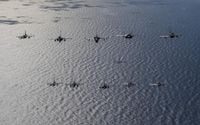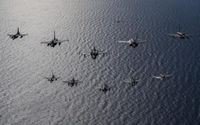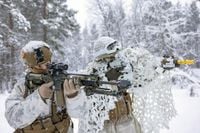NATO is gearing up for its upcoming joint exercise, Ramstein Flag 2025, which is set to commence on March 31 and run through April 11, 2025. When the event unfolds, over 90 military aircraft from more than 15 allied nations will converge, showcasing a significant display of international military collaboration at 12 operational air bases across Europe, primarily centered at the Royal Air Force Netherlands’ Leeuwarden Air Base.
This major wartime simulation focuses on modern combat scenarios, with a particular emphasis on countering anti-access/area denial (A2/AD) tactics, integrated air and missile defense, and agile combat employment. According to U.K. Air Marshal Johnny Stringer, deputy commander of NATO Allied Air Command, the exercise is designed to enhance interoperability among allied military forces, allowing them to operate cohesively in a contested environment.
“Participation from over 15 NATO allied countries allows us to conduct a number of high-end missions within realistic combat scenarios,” Stringer remarked during a recent media briefing. “Our priorities for the exercise this year include exercising what we call counter-anti access/area denial missions, integrated air and missile defense, and also practicing agile combat employment—all underpinned by rapid and seamless sharing of information across nations.”
Lt. Gen. André Steur, commander of the Royal Netherlands Air Force, echoed these sentiments, underscoring the importance of training together. “We sometimes underestimate that value of actually knowing the folks you’re going to possibly go to war with. This exercise allows us to practice interoperability during the sprawling exercise in which NATO fighters and support planes will operate alongside special forces and naval units,” he stated.
The exercise aims to improve the survivability of NATO troops and their equipment while simultaneously complicating adversaries’ ability to target them. Stringer hinted at the focus on cross-servicing aircraft, which involves one nation's engineers or maintainers facilitating the turnaround between missions of another nation's aircraft type. This operational facet, while having seen improvements over the past three years, was a common practice during the Cold War.
“Cross-servicing encompasses one nation’s engineers or maintainers doing the turnaround between missions of another nation’s aircraft type,” he explained, noting that NATO's previous exercises have successfully integrated this practice but are now set to push the boundaries further during Ramstein Flag 2025.
This exercise is not the first of its kind; the inaugural iteration of Ramstein Flag occurred in October 2024 in Greece, boasting participation from over 130 aircraft from 12 nations. The exercise’s structure drew inspiration from the U.S. Air Force's renowned Red Flag exercises, which aim to train under conditions that mimic real combat scenarios.
Stringer elaborated on the significance of spreading operations over multiple bases, stating, “It makes briefing, debriefing, etc., a whole lot easier. But we won’t have that luxury for real in wartime, and we need to be able to practice it dispersed across locations. That is one of the things we’re getting at during Ramstein Flag.” This is particularly critical given the evolving landscape of military engagements where forces need to adapt swiftly to diverse operational challenges.
Highlighting another aspect of Ramstein Flag 2025, Stringer pointed out the necessity of addressing technological challenges and connectivity issues that could hinder NATO's ability to execute joint operations effectively. “When we were trying to pass critical data, whether at the planning stage or during the execution stage, were we able to get it through? Did the networks we set up actually work?” he questioned, stressing the importance of using this exercise to identify potential faults that could compromise mission success.
Furthermore, the implications of the ongoing military conflict in Ukraine have shaped this year's training focus. Steur indicated the importance of understanding air superiority, a crucial factor in modern warfare, by stating, “When none of the parties are able to establish air superiority, then warfighting becomes extremely difficult. Our training with Ramstein Flag aims to ensure we can facilitate freedom of maneuver on the surface.”
International dynamics also play a significant role in the exercise, especially amid rising tensions with Russia and the ongoing critique from U.S. President Donald Trump regarding NATO member countries’ defense spending. Trump has previously expressed concerns over alliance members' failure to meet the benchmark of allocating at least 2% of their GDP to defense.
Stringer responded to the impact of such geopolitical factors, asserting, “All relationships, all alliances probably have their ups and downs. But what you’re seeing in Ramstein Flag is some of the highest-end training we’re able to conduct in Europe across a raft of nations.” He added that collaboration among all 32 NATO nations is essential for developing the necessary skills to keep Europe secure.
As the countdown to Ramstein Flag 2025 continues, allied forces are preparing for what promises to be one of NATO’s most extensive and comprehensive military exercises in recent years. Participants are not only honing their combat skills but also emphasizing the critical need for interoperability and preparedness amid a complex global security landscape.






